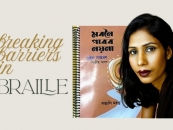-853X543.jpg)
KALEIDOSCOPE: ARUN KHOPKAR’S CHALAT CHITRAVYOOH IN TRANSLATION
by Satyabrata Ghosh February 9 2025, 12:00 am Estimated Reading Time: 7 mins, 57 secsExploring Arun Khopkar’s reflections on cinema, creativity, and collaboration, this piece by Satyabrata Ghosh who has translated the book in Bengali, explores rare insights from Indian filmmakers who break their silence to preserve and celebrate artistic legacies.
Arun Khopkar's Chalat Chitravyooh offers a profound exploration of Indian cinema, blending personal reflections with rich insights into filmmaking legends like Ritwik Ghatak, Mani Kaul, and Bhupen Khakhar. This article highlights Khopkar’s experiences at FTII, his films on cultural icons such as Narayan Surve and Charles Correa, and his journey in documenting India’s artistic legacies. By discussing the struggles of preserving traditional arts and cinematic excellence, Khopkar inspires future filmmakers and scholars. Find out how his writings continue to shape the understanding of Indian cinema and creativity for generations.
The Silence of Indian Filmmakers
It's still common among Indian filmmakers to shy away from sharing their thoughts about their filmmaking experiences. They often echo a common sentiment, “The films will speak for themselves." Surely, films do speak if they narrate compelling stories. Watching and consuming their works enriches our personal experiences by offering new perspectives on life, relationships, and society. However, the filmmaker's personal reflections, insights into the creative process, and the challenges faced along the way can add an invaluable layer of understanding for audiences and future filmmakers alike.
This lack of openness in sharing experiences is particularly noticeable in contrast to the practices of filmmakers in other parts of the world. In regions such as Europe and the United States, the culture of film criticism, retrospectives, and filmmaker memoirs thrives. Acclaimed directors often write books, give detailed interviews, and hold workshops, allowing cinephiles and scholars to dive deeper into the art and craft of cinema. This openness has contributed to a strong culture of film scholarship and documentation. In India, unfortunately, the situation is different. Filmmakers here often refrain from publicly reflecting on their works, possibly due to concerns about being misinterpreted or the belief that films should stand on their own without explanation.
However, this is not the case when we observe real lives unfolding without a script. A filmmaker must develop an idea, nurture it constantly either in their mind or on paper before shooting, and then assemble the rushes to shape the final film. It’s a dynamic process of creating a parallel universe. As cinephiles, we crave insights into this process, hoping to understand how ideas germinate and evolve into powerful cinematic experiences.
In our formative years, we cherished the rare instances when filmmakers graciously shared their thoughts in print or interviews. These insights shaped our understanding of the medium and offered glimpses into the minds of those who created the films we admired. Yet, such moments have remained few and far between. While some directors in India, like Satyajit Ray and Mrinal Sen, left behind writings and commentaries on their films, the vast majority have maintained a culture of reticence.
17.jpg)
Arun Khopkar: A Rare Voice in Indian Cinema
Fortunately, we still have veteran filmmaker Arun Khopkar with us—an artist who has consistently shared his experiences and perspectives. Alongside his filmmaking career, Khopkar has been engaged in researching and writing extensively on cinema, producing articles and books in Marathi and English. His writings provide a rare and much-needed window into the creative process. His books have received critical acclaim and are now being translated into Hindi and other Indian languages, broadening their reach. I feel doubly blessed to have had the opportunity to translate two of his works into Bengali, an enriching experience that deepened my appreciation of both cinema and literature.
One of Khopkar's most renowned works, Chalat Chitravyooh, explores the lives and works of eminent personalities he has encountered or depicted in his films. The book offers profound insights into his creative collaborations, inspirations, and the philosophies that have shaped his cinematic vision. In particular, Khopkar's reflections on his time at the Film and Television Institute of India (FTII), Pune, are both nostalgic and enlightening. He fondly recalls the influence of some of the best teachers at the institute, whose mentorship played a crucial role in his artistic growth.
The most poignant section of the book is Khopkar’s account of Ritwik Kumar Ghatak, his mentor. Ghatak’s impact on Khopkar as both a teacher and a filmmaker is evident in every word. Khopkar highlights how Ghatak transformed the personal trauma of the Partition into an epic cinematic narrative, elevating films such as Meghe Dhaka Tara (1960), Komal Gandhar (1961), and Subarnarekha (1965) to timeless masterpieces. According to Khopkar, what defines these films as "epic" is not their scale or budget but Ghatak’s deep compassion for humanity and his ability to channel personal grief into universal themes.
This exploration of Ghatak’s work is a vital contribution to Indian film scholarship. Firsthand accounts of Ghatak’s teaching methods and artistic philosophy are rare, and Khopkar’s writings offer an intimate portrait of the man behind the films. Ghatak's work continues to inspire filmmakers and scholars, and Khopkar’s reflections add to our understanding of his enduring legacy.
Reflections on Artistic Collaborations
In another section of Chalat Chitravyooh, Khopkar reflects on his encounters with Mani Kaul, one of India’s most avant-garde filmmakers. Khopkar recalls his early experience working as the lead actor in Kaul’s adaptation of Mohan Rakesh's play Ashad Ka Ek Din (1971). The demanding nature of the shoot, coupled with Kaul’s unconventional approach to storytelling, left a lasting impression on Khopkar. Inspired by this experience, he applied to FTII, where he would later come to appreciate the depth and originality of Kaul’s vision.
Kaul’s films, known for their minimalism and meditative pacing, challenged traditional narrative structures. Khopkar meticulously analyses Kaul’s documentaries and short films, highlighting their spiritual and philosophical underpinnings. This section of the book serves as a powerful reflection on the creative dialogue between two filmmakers and the mutual respect that shaped their artistic journeys.
Khopkar also devotes significant attention to other cultural icons he has worked with, including poet Narayan Surve and architect Charles Correa. His film on Surve captures the poet’s empathetic portrayal of working-class struggles, while Volume Zero (2009) explores Correa’s architectural philosophy. In his writings, Khopkar emphasizes the importance of empathy and imagination in capturing the essence of his subjects. He discusses how Surve’s poetry influenced his editing choices and how Correa’s designs inspired him to think about space and form in new ways.
The book further pays tribute to the mentors and colleagues who shaped Khopkar’s time at FTII. Satish Bahadur, a pioneering film teacher, is celebrated for his innovative teaching methods, which included analysing film narratives through a format akin to musical notation. Bhaskar Chandavarkar, a music composer and sound pioneer, is remembered for his dedication to nurturing the creative potential of aspiring filmmakers. Chandavarkar’s influence on sound design at FTII was revolutionary, laying the groundwork for future generations of sound artists.
Preserving Artistic Legacies
Chalat Chitravyooh is not just a memoir; it is also a reflection on the importance of preserving artistic legacies. Khopkar’s film Colours of Absence (1993) documents the life and art of painter Jehangir Sabavala, capturing the intricate relationship between the artist’s vision and his environment. Khopkar describes the challenges of conveying Sabavala’s creative spirit through film, emphasizing the need to engage with the subtleties of colour, light, and composition.
Similarly, his film Figures of Thought (1990) explores the world of Bhupen Khakhar, an artist known for his bold depictions of marginalized lives. Through extensive research and personal conversations with Khakhar, Khopkar explores themes of loneliness, homosexuality, and social critique. His empathetic writing brings Khakhar’s world to life, allowing readers to appreciate the courage and individuality that defined the artist’s work.
The book also discusses the contributions of Raghunath Krishna Joshi (R-Kri), a pioneering calligrapher and researcher. Khopkar laments the decline of handwriting in the digital age and stresses the importance of preserving the beauty of handwritten expression. Joshi’s work in developing computer fonts remains a testament to the enduring relevance of calligraphy in modern design.
In the later chapters, Khopkar reflects on the legacy of cinematographers KK Mahajan and Subrata Mitra. Mitra’s frustration with poor film projection standards stresses the need to prioritize the preservation and restoration of cinematic works. Even traditional folk performing arts like tamasha have not escaped the insidious march toward obscurity. In discussing the indigenous stagecraft of Dadu Indurikar, the author recalls the Hanuman Theatre, a tent in Parel where folk artists thrived and performed for extended periods. Following Indurikar’s passing, neither his play Garbache Lagne nor the Hanuman Theatre has endured. No plaque has been installed there to mark the vibrant legacy that these artists and performers cultivated in that space over the years.
Translating a Cultural Masterpiece
Translating Chalat Chitravyooh into Bengali has been a transformative journey for me. Despite Bengal’s rich literary heritage, I found few books that truly engage with contemporary human experiences as deeply as this one. Ritwik Ghatak’s words—“If you can think of making films, then you can very well write about films”—resonated with me throughout the process. Translating Khopkar’s reflections has empowered me to look forward with renewed commitment to human expression through storytelling.

16.jpg)



-173X130.jpg)

-173X130.jpg)
-173X130.jpg)
-173X130.jpg)
-173X130.jpg)
-173X130.jpg)
-173X130.jpg)